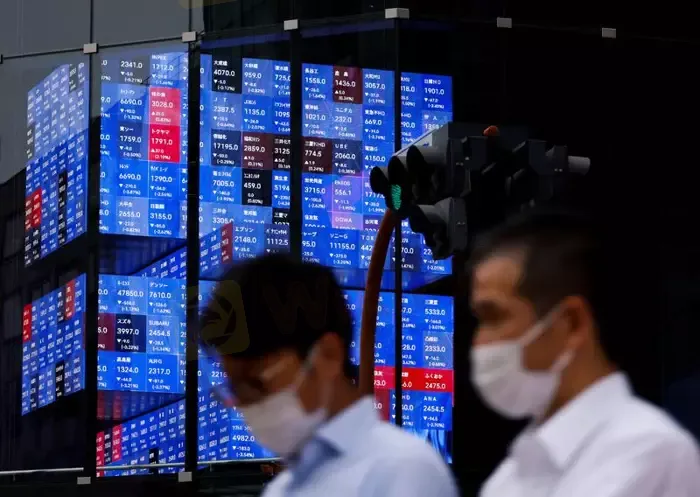简体中文
繁體中文
English
Pусский
日本語
ภาษาไทย
Tiếng Việt
Bahasa Indonesia
Español
हिन्दी
Filippiiniläinen
Français
Deutsch
Português
Türkçe
한국어
العربية
Shares on guard for U.S. inflation, earnings tests
Abstract:Asian shares started cautiously on Monday as investors braced for a U.S. inflation report that could force another super-sized hike in interest rates, and the start of an earnings season where profits could be under pressure.

An upbeat U.S. June payrolls report already has the market wagering heavily on a rise of 75 basis points from the Federal Reserve, sending bond yields and the dollar higher.
Underlining the global nature of the inflation challenge, central banks in Canada and New Zealand are expected to tighten further this week. [NZ/INT] [CA/INT]
While Wall Street did eke out some gains last week, the market mood will be tested by earnings from JPMorgan and Morgan Stanley on Thursday, with Citigroup and Wells Fargo the day after.
“Consensus expects 2Q S&P 500 EPS (earnings per share) growth of just +6% year/year,” says Goldman Sachs analyst David J. Kostin. “While firms will likely clear this low bar, we expect cautious commentary will prompt cuts to forward estimates.”
If the economy does manage to dodge recession, Kostin sees EPS growth of 8% in 2022 and 6% in 2023, with the S&P 500 index rising to 4,300. In a moderate recession, EPS could fall by 11%.
On Monday, S&P 500 futures were down 0.4% and Nasdaq futures off 0.5%. EUROSTOXX 50 futures fell 0.6% and FTSE futures 0.7%.
Chinese blue chips lost 1.2% after Shanghai discovered a COVID-19 case involving a new subvariant, Omicron BA.5.2.1.
MSCI‘s broadest index of Asia-Pacific shares outside Japan slipped 0.7%. Going the other way, South Korea firmed 0.1% and Japan’s Nikkei added 1.6%.
Japans conservative coalition government was projected to have increased its majority in upper house elections on Sunday, two days after the assassination of former prime minister Shinzo Abe.
A major hurdle will be Wednesdays U.S. consumer price report, in which markets see headline inflation accelerating further to 8.8% but a slight slowdown in the core measure to 5.8%.
An early reading on consumer inflation expectations this week will also have the close attention of the Fed.
“Unexpected weakness in these releases will be required to dislodge expectations for a 75bps July 27 Fed rate rise, which lifted from about 71bps to 74bps post the payrolls report,” said Ray Attrill head of FX strategy at NAB.
Parity party
Likewise, Treasury yields climbed around 10 basis points on the jobs report and the 10-year stood at 3.09% on Monday, up from a recent low of 2.746%.
A hawkish Fed combined with fears of recession, particularly in Europe, has kept the dollar up at 20-year highs against a basket of competitors. The dollar broke above 137.00 to reach its highest since 1998 at 137.10 yen as the Bank of Japan remained dovish.
The euro continued to struggle at $1.0140, having shed 2.4% last week to hit a two-decade low and major retracement target at $1.0072.
“With little economic relief on the horizon for Europe, and U.S. inflation data likely to mark a new high for the year and keep the Fed hiking aggressively, we think the risks remain skewed in favour of the greenback,” said Jonas Goltermann, a senior markets economist at Capital Economics.
“Indeed, we think the EUR/USD rate will break through parity before long, and may well trade some way through that level.”
Rising interest rates and a strong dollar have been a headache for non-yielding gold, which was ailing at $1,740 an ounce, having fallen for four weeks in a row. [GOL/]
Oil prices also lost around 4% last week as worries about demand offset supply constraints. [O/R]
Data from China due on Friday are likely to confirm the worlds second-largest economy contracted sharply in the second quarter amid coronavirus lockdowns.
On Monday, Brent was trading 72 cents lower at $106.30, while U.S. crude eased 89 cents to $103.90 per barrel.

Disclaimer:
The views in this article only represent the author's personal views, and do not constitute investment advice on this platform. This platform does not guarantee the accuracy, completeness and timeliness of the information in the article, and will not be liable for any loss caused by the use of or reliance on the information in the article.
Read more

WikiFX Review: Is PU Prime a decent broker?
In today’s article, we have made a comprehensive review of a broker named PU Prime. We wonder if PU Prime is a scam or a reliable broker.

Doo Financial Expands Reach with Indonesian Regulatory Licenses
PT. Doo Financial Futures, a subsidiary of the global financial services brand Doo Group, has secured regulatory approval from Indonesia’s Badan Pengawas Perdagangan Berjangka Komoditi (BAPPEBTI).

Investment Scams in Malaysia: Telegram Tops Scammers’ List
In the first 11 months of 2024, Malaysia recorded 5,685 investment scams, with Telegram emerging as the most commonly used platform for fraudulent activities.

What Are The Common Types of Unregulated Forex Brokers?
Protect your investments from unregulated forex brokers with these tips. Learn about red flags, scams, and how the WikiFX app ensures safe trading experiences worldwide.
WikiFX Broker
Latest News
Spotware Unveils cTrader Store, Global Marketplace for Algo Creators
Elderly Trader Loses RM2.1M in WhatsApp Forex Scam
Gigamax Scam: Tracking Key Suspects in RM7 Million Crypto Fraud
Singaporean Arrested in Thailand for 22.4 Million Baht Crypto Scam
Trader Turns $27 Into $52M With PEPE Coin, Breaking Records
ASIC Sues HSBC Australia Over $23M Scam Failures
CFI Partners with MI Cape Town, Cricket Team
Doo Financial Expands Reach with Indonesian Regulatory Licenses
WikiFX Review: Is IQ Option trustworthy?
5 Questions to Ask Yourself Before Taking a Trade
Currency Calculator


